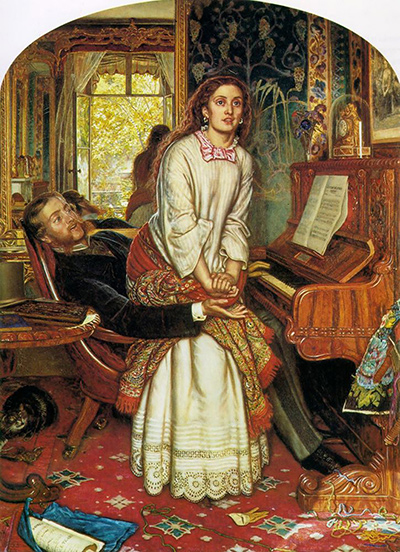William Holman Hunt painted The Awakening Conscience with oils on canvas in 1853. It was a commissioned piece for Thomas Fairbairn, an industrialist in Manchester.
The painting was inspired by verse 25:20 in the Book of Proverbs: " As he hath taketh away a garment in cold weather... so it is he that singeth songs to a heavy heart".
Hunt chose to portray the sentiment with a moral issue pertinent to the times and hired a "maison de convenance", a place where gentlemen would take their lovers, in which to set his scene.
The painting is fascinating and filled with details and symbology. However when the painting was first displayed much of the interest was around Annie Miller, Hunt's girlfriend.
Miller, who was the model for this painting, was only 15 when she met Hunt and was described as an "uneducated barmaid". Her original expression in the painting was more of pain and horror which shocked the critics and eventually disturbed the owner. Fairbairn asked Hunt to soften the woman's expression to create the version seen now.
In the painting a man reclines in a chair by the piano. The couple appear to have been singing and playing "Oft in the Stilly Night" which is a sad song pertaining to missed opportunities.
Another song lies on the floor, titled "Tears, Idle Tears". As if struck by a thought or a moment of revelation, the mistress (she wears jewellery but no wedding ring), rises from the man's lap and stares out into the garden which we see reflected in the mirror behind them. Experts have suggested that her reflection portrays her lost innocence and the ray of light in the foreground her possible redemption.
Much of the rest of the scene emphasizes her situation as "the kept woman". A cat sits under the table with a bird it has caught, a "tangled web" of yarn can be seen near the piano, the gentleman's hat and gloves have been cast off in a hurry, one glove lies fallen on the floor.
Without his support, she could be a "fallen woman", yet he is still holding her back. Hunt also continued his message on the frame of the picture using bells as a warning symbol, marigolds to represent sorrow and a star for the spiritual revelation.
According to Art Historians the furnishings in the scene are interesting too for they are all new and hardly used in contrast to those in a typical family home.
"The Awakening Conscience" is a wonderful comment about Victorian society which now hangs in the Tate Gallery London.




